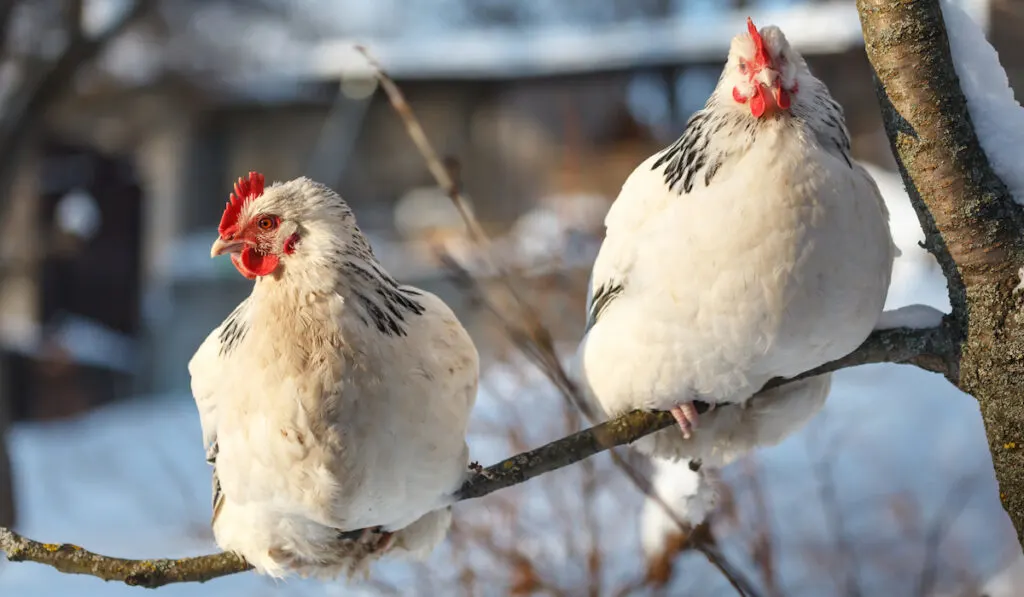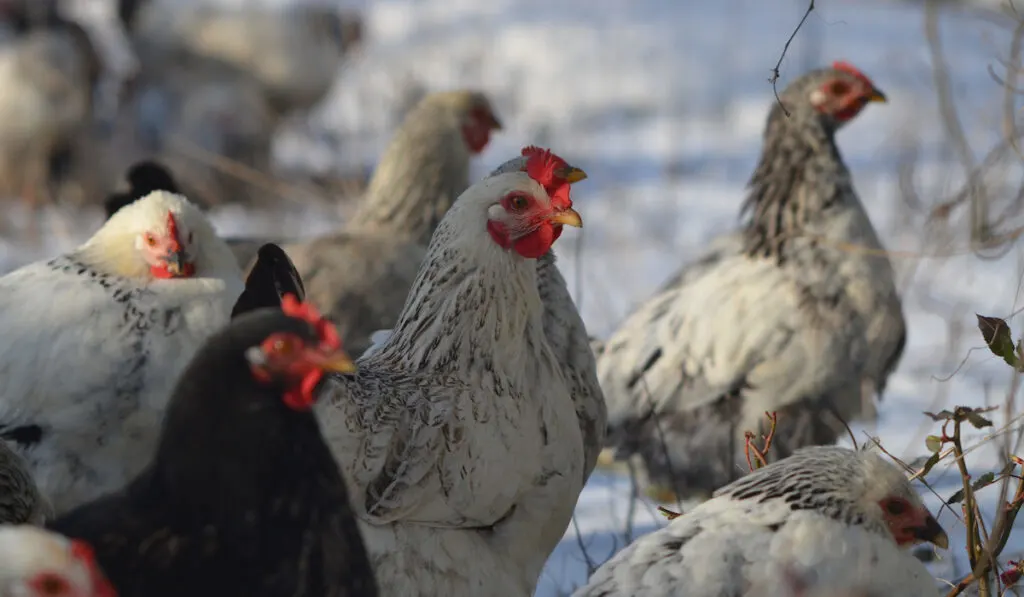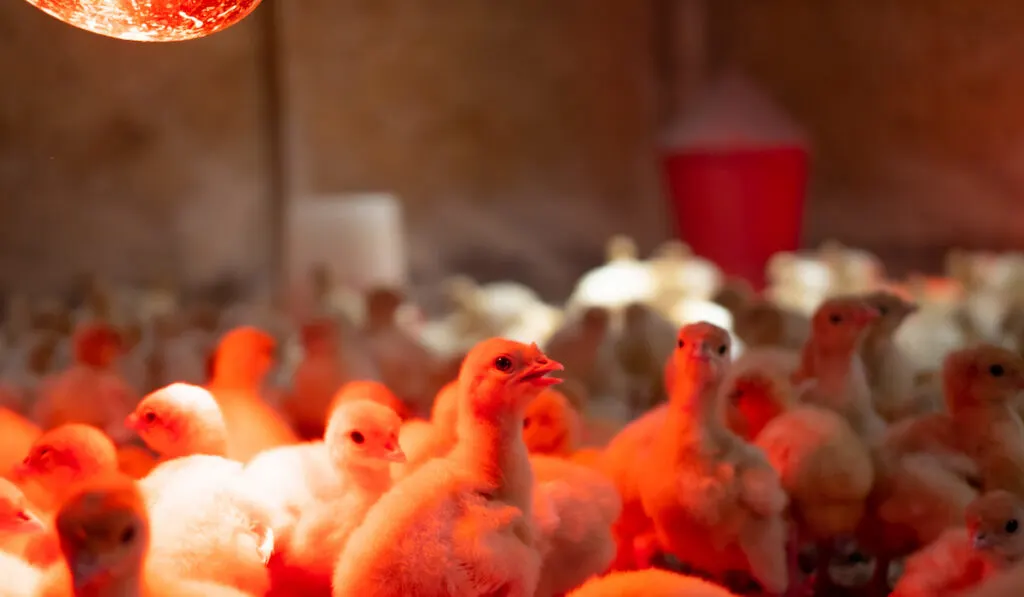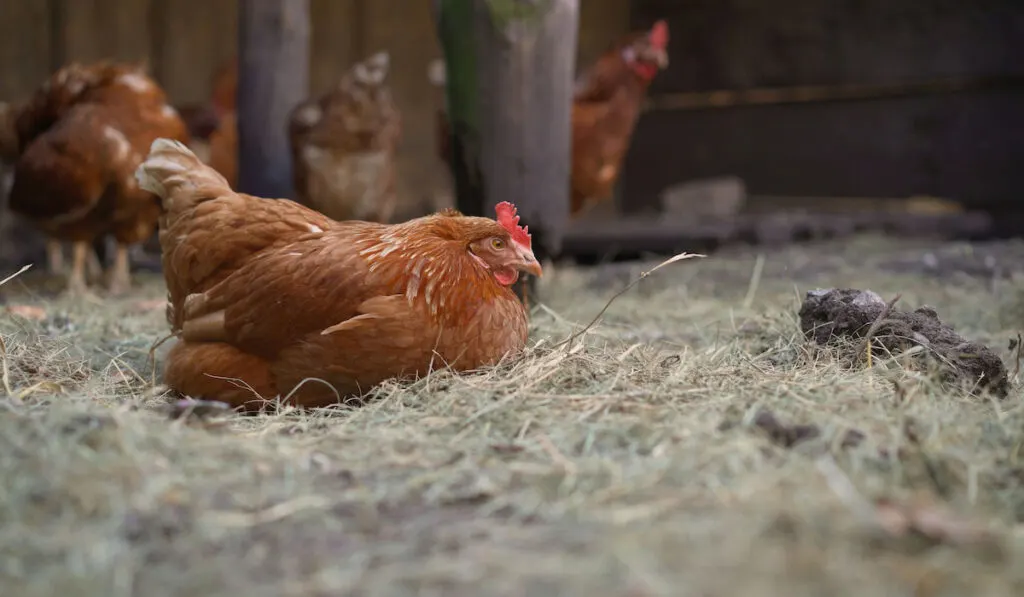Raising chickens is fun and easy until you are faced with a major challenge. One challenge that poultry farmers face is winter.
During winter, you may fear for the safety of your birds. How do you care for your chickens in winter? Must you give your chickens a heat lamp? Read this article
Will your chickens die without a heat lamp in winter? Heat lamps are very important in keeping chickens warm in winter. You need to install heat lamps to keep your birds warm and alive during the winter.
Are there other tips to care for your chickens during the winter? How do you promote egg production in winter? Continue reading.

Raising Chickens In Winter
Even though it is not difficult to raise chickens in winter, you need to give more care and attention to your birds. The first thing you should know is the temperature requirement of your chickens.
Chicken Temperature Requirements
Chickens need around 95 °F when they hatch. Their temperature need reduces to 70 °F when they are over 4 weeks old (after brooding).
During winter, the temperature can reduce to 30°F (higher or lower according to the region). This means that the temperature of winter is way below the temperature need of your chickens.
Note that the specific temperature needs of your chickens depends on the breed you are raising.
Signs that Your Chickens Are Too Cold
Here are some signs that your chickens are feeling too cold:
1. Every Bird Is Standing Under the Heat Lamp
Happy chickens are evenly distributed when the temperature is just right. When the temperature is low, chickens will all stay under or around the heat lamp. Your chickens are cold when most of them do not want to leave the heat lamp.
2. Your Chickens Are Huddling
If the heat lamps do not produce enough heat, your birds will cluster and huddle together. Remember that when your birds are happy and the temperature is just right, your chickens will be evenly distributed.
3. Standing on One Foot
Cold chickens will stand on one foot. This is common when there is no proper bedding on the floor of the coop. When the ground is cold, chickens will stand on one foot and raise the other foot. They will usually tuck the raised foot into their body so that the heat from the body can keep the foot warm.
4. Swelling on Their Face
Cold birds can develop swelling on their faces. If you observe some swelling around the eyes and beak of your chickens, you should increase the temperature in the coop as your birds are too cold.
Swelling on the face of your birds can also be a sign of various infections, so make sure that you contact your vet.

5. They Lay Fewer Eggs
If you have pullets or layers, you will observe a reduction in the number of eggs your chickens lay daily. Chickens either lay very few or no eggs at all during winter (because of the cold temperatures and reduced daylight hours).
Later in this article, we will discuss how to promote egg production during winter.
6. Sneezing, Difficulty in Breathing, and Other Respiratory Issues
When your chickens are cold, they may find it difficult to breathe well. They can also sneeze and release droplets while they breathe. Cold birds are relatively slow and do not breathe properly.
7. Some Are Dying
Now, you should not wait for any bird to die before you know that they are feeling too cold. With the other signs listed above, you can tell when your birds are cold. If, however, you neglect the signs and leave your birds alone during the winter, you may lose a few.
Now that you know how to identify cold chickens, how do you care for chickens in winter? Continue reading.
Best Ways to Raise Birds in Winter
Here are helpful tips for you:
1. Use Heat Lamps
Heat lamps are by far the most important tools in poultry. Heat lamps do not just provide light to your chickens at night (which encourages them to eat at night and grow faster), heat lamps also give them the extra heat for the winter.
If all your chickens are clustered under or around your heat lamps, you should install more heat lamps as the existing ones may not be enough. Happy chickens are evenly distributed around the coop when the temperature is just right.
2. Increase the Layer of Bedding
Bedding is necessary for chickens of all ages. With proper bedding, your chickens will not walk on the cold ground of winter. Some proven bedding materials are:
- Sawdust
- Hay or Straw
- Wood Shaving
- Recycled Paper
- Shredded Leaves
Make sure that you have a thick layer of bedding. Bedding does not just prevent your birds from having contact with the cold floor, bedding also traps warm air that can increase the temperature of the coop.

3. Insulate the Coop
You must insulate the coop during winter. Insulation prevents hot air from leaving the coop, so your birds will feel warmer in winter. Here are some insulation tips:
- Use Styrofoam to Coat the Wall: Styrofoam prevents cold from entering the coop. When you line the coop wall with styrofoam, you prevent your birds from feeling too cold. Coating the coop wall with styrofoam also prevents drafts.
- Check for and Fix Drafts: Drafts are little holes in the wall through which wind can enter the coop. Chickens hate cold wind cause it can make them sick. Make sure that every draft is blocked.
- Bedding: Provide bedding for your birds.
- Heat Lamps: Remember that the use of heat lamps cannot be overemphasized.
What about proper ventilation? Many homesteaders do not properly ventilate their chicken coop because of insulation. You can insulate and ventilate the coop at the same time.
Without ventilation, moisture will build up in the coop over time and it can cause microbial (i.e. bacterial or fungal) infections in your birds. Ventilation also encourages airflow, so your birds will have enough oxygen.
How do you ventilate your coop? Apply the tips below:
- Adjustable Flaps or Sliding Covers: You need to install vents, windows, and doors that can be easily opened or closed according to need.
- Drill Holes near the Top (Just Below the Roof): You need to allow ammonia and CO2 to escape the coop. Drill holes near the top of the coop to allow gases to leave the coop. You can cover the holes with hardware cloth (1/4 inch squares)
Remember that you should insulate and ventilate the coop.
4. Give Your Chickens Grain at Night
Giving your chickens grains at night will not just make them grow quickly, it will also keep them busy (which can make them warm).
When digesting feed, animals (including chickens) produce heat. This is why you can become a bit sweaty when you eat some kinds of food. Chickens also will produce heat when you feed them with grains, so you should give your chickens grain at night.
Examples of grains that you can give to your birds are:
- Rye
- Millet
- Barley
- Wheat
- Sorghum
What if your chickens are sleeping instead of eating? It means that they do not have enough light.
When there is sufficient light in the coop, chickens will eat continuously. Sleeping chickens can become cold faster than eating and active chickens.
5. Raise Cold-Hardy Breeds
If you live in places where the winter can get very cold, you should raise cold-hardy breeds. Some examples of cold-hardy breeds are:
- Delaware
- Dominique
- Wyandotte
- Welsummer
- New Hampshire Red
Cold-hardy chicken breeds do not just survive the low temperatures of winter, they are also productive (i.e. lay eggs and grow bigger).
Awesome tips, right?
Raising Layers in Winter
Do you have layers? Layers or pullets are females of chicken breeds that were selectively bred for egg production.
This means that, unlike other chicken breeds, layers produce more eggs (some can produce 3 eggs in 2 days). Some examples of breeds that lay eggs quickly are:
- Red Sex Link
- Ameraucana
- White Leghorns
- Rhode Island Red
- Barred Plymouth Rock
Sadly, egg production can drop or cease in winter. When birds are cold, most of the energy they previously use to produce and lay eggs will be used to keep the birds warm. Layers rest in the winter and continue laying when winter is over.
If you want your layers to produce more eggs in winter, use the tips below:

1. Insulate the Coop Properly
When the coop is cold, layers will stop producing eggs and rest. To prevent your birds from resting, do not allow them to feel cold. You should keep the coop warm (according to the preferred temperature needs of your specific breed).
When the coop is warm enough, your birds will continue laying eggs.
2. Restrict Their Movement
When layers walk, they consume energy. Your goal should be to prevent your birds from spending their energy on activities that are not egg production and laying. To increase egg production, keep your layers in a confined place full of feed.
When your layers do not move, you can easily find the eggs.
3. Give Them More Protein and Calcium-Rich Feeds
Birds produce eggs with nutrients in their body. The most essential nutrients in egg production are protein and calcium. To encourage more egg production, give your birds protein and calcium-rich feeds.
Examples of calcium and protein-rich feeds for your birds are:
- Maggots (protein)
- Soybeans (protein)
- Limestone (calcium)
- Oyster shells (calcium)
- Fishbones and scales (calcium)
- Processed feeds (protein and calcium)
Giving your birds these nutritious meals will ensure that your birds continue to produce eggs during the winter.
Final Thoughts
Chickens are fun to raise, but they need your care especially during the winter.
Even though installing heat lamps is not the only way to care for your chickens during the winter, you should make sure that you install as many heat lamps as your chickens need.

